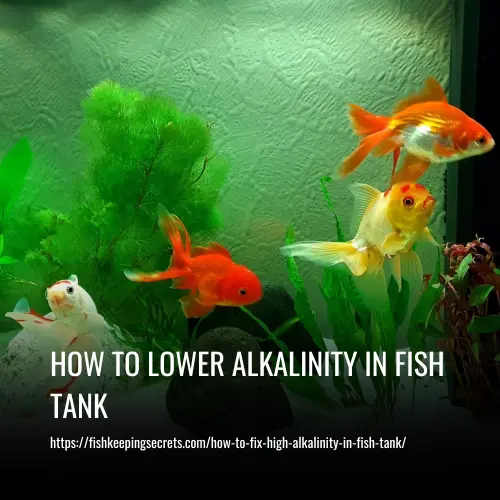How To Lower KH In Fish Tank
This post contains affiliate links. As an Amazon Associate, we earn from qualifying purchases.
Having the right water parameters, such as the carbonate hardness (KH), is essential for maintaining a healthy and thriving fish tank. High KH levels can lead to problems such as pH fluctuations and difficulty in maintaining stable water conditions. Therefore, it’s important for fish keepers to know how to lower KH in their fish tank.
To lower KH in fish tank, follow these steps:
- 1. Using Acid Buffers
- 2. RO/DI Water
- 3. Distilled Water
- 4. Indian Almond Leaves
- 5. Peat Moss

How To Lower KH In Your Aquarium
Lowering the KH in your aquarium is important for fish and plants that are sensitive to water chemistry. To lower the KH, you need to strike a balance with the pH to avoid drastic fluctuations that can harm your fish. Keep in mind that this process is mainly for freshwater tanks.
1. Using Acid Buffers
Acid buffers are effective in converting KH into CO2, which lowers the pH levels and KH. However, it’s important to use acid buffers cautiously, especially if your tank does not have live plants. Using too much acid buffer can cause a sudden drop in pH and excess CO2, which can be harmful to your fish. Follow the product instructions carefully and gradually increase the use of acid buffer to avoid overdosing and harming your fish.
2. RO/DI Water
Reverse Osmosis (RO) systems and Deionization (DI) filters are methods of creating pure water with no KH. While setting up these systems may be expensive initially, they can save you money in the long run compared to buying distilled water regularly. When using RO/DI water for your fish tank, it’s important to mix it with tap water to ensure a small amount of KH and GH is present. This allows you to balance and adjust the KH levels in your tank by varying the amount of RO/DI water used.
Marine and reef aquarists commonly use RO/DI units as a routine solution, especially for larger tanks. It provides clean and balanced water conditions necessary for these types of aquariums.
3. Distilled Water
Distilled water is a pure form of water that is free from impurities and minerals. It is created by evaporating water and collecting the steam, leaving behind any impurities. You can purchase distilled water from your local grocery store if you do not want to make it yourself.
When using distilled water for your fish tank, it is important to mix it with tap water to maintain the necessary GH and KH levels. You can add 50% tap water to your distilled water, using an aquarium water test kit to determine the correct ratio and levels.
One drawback of using distilled water is that it can be expensive, especially for larger aquariums. However, if you have a nano tank, a combination of distilled water and tap water can be a suitable solution.
4. Indian Almond Leaves
Indian Almond leaves are a natural solution for lowering the pH and KH in freshwater fish tanks. They are especially beneficial for fish species that thrive in a blackwater river ecosystem or betta tanks. When the leaves decompose, they release tannic acid, which breaks down the KH levels in the water. Additionally, these leaves are known to have medicinal properties that help protect fish from bacteria and aid in wound healing. However, it’s important to note that the effects are gradual, so if your water has a very high KH, you may not see a significant difference.
5. Peat Moss
Peat moss can be placed in a mesh bag or clean stocking and added to your filter media. Like Indian Almond leaves, peat moss leaches tannins into the water, resulting in a slight reduction in KH and pH levels. It is best suited for situations where you only need a small decrease in KH. It’s crucial to use aquarium-safe peat moss rather than the variety found in garden centers, as the latter may contain chemicals that can harm fish and plants.
Remember to test your water regularly to monitor the KH levels and make adjustments accordingly. It’s important to maintain stable water parameters for the health and well-being of your aquarium inhabitants.
What Is Aquarium Water KH
Aquarium water KH refers to carbonate hardness, which measures the levels of bicarbonates and carbonates dissolved in the water. It helps stabilize the pH level by buffering against acids. If the KH level is too low, the pH may fluctuate, which can be harmful to fish. High KH levels neutralize more acid before affecting the pH. KH is also referred to as alkalinity, but it should not be confused with alkaline, which refers to the opposite end of the pH scale. KH can also be called temporary hardness, buffering capacity, total alkalinity, or acid-neutralizing capacity. These terms are interchangeable and refer to the same concept.
What’s So Important About KH In Your Fish Tank
One of the key reasons why KH is important in your fish tank is because it helps prevent fluctuations in pH levels. Fluctuations in pH can be harmful to your fish and can even lead to their death. Acids are constantly being produced in the aquarium through the decomposition of organic waste by beneficial bacteria in the biological filter.
These acids, such as ammonia, nitrite, and nitrate, can gradually decrease the pH of the water. However, if the KH in your tank is at a sufficient level, it can neutralize the acids and prevent the pH from falling to toxic levels. This is crucial for maintaining a healthy environment for your fish and plants.
Additionally, in marine tanks, KH is especially important for the health of corals, as they rely on carbonate to build and maintain their exoskeletons. Therefore, monitoring and maintaining the KH level in your tank is essential for the overall well-being of your aquatic ecosystem.
Symptoms Of High KH In An Aquarium
Recognizing the symptoms of high KH in your aquarium is crucial for maintaining the health and well-being of your fish and plants.
1. Cloudy or Discolored Water
One of the noticeable symptoms of high KH is cloudy or discolored water. This occurs due to the precipitation of minerals in the water, indicating a high KH level. Regular testing of your water parameters will help identify and address this issue.
2. Poor Plant Growth
Excessive KH levels can inhibit plant growth in your aquarium. Plants require a balanced level of KH for nutrient absorption. If you notice that your plants are not thriving or growing as they should, it could be a sign of high KH levels. Adjusting the KH level through water changes or using specific products can help promote healthy plant growth.
3. Abnormal Fish Behavior or Appearance
High KH can cause stress in fish, making them more vulnerable to diseases and infections. Observe your fish for any abnormal behavior or appearance, such as lethargy, rapid breathing, clamped fins, loss of appetite, stunted growth, or deformed spines. If you notice these symptoms, it is important to address the high KH levels in your aquarium to ensure the well-being of your fish.
Regular monitoring of your water parameters and taking corrective measures when necessary will help maintain a balanced KH level in your aquarium, promoting a healthy and thriving aquatic environment.
What KH Level Does My Tank Need
The ideal KH (carbonate hardness) level for your tank will vary depending on the livestock and plants you have. The table below shows recommended levels in degrees of KH, which is equivalent to 17.9 ppm (parts per million). These are general guidelines and may need to be adjusted based on your specific tank setup.
Aquarium KH Levels
| Aquarium Type | |
|---|---|
| Tropical | 4 to 8 dKH |
| Shrimp tank | 2 to 5 dKH |
| African Cichlid | 10 to 18 dKH |
| Discus | 3 to 8 dKH |
| Planted tank | 3 to 8 dKH |
| Brackish environment | 10 to 18 dKH |
| Pond Habitat | 4 to 8 dKH |
| Marine Saltwater Aquarium | 8 to 12 dKH |
| Reef Tank | 8 to 12 dKH |
It is important to note that different livestock and plants may have specific KH level requirements, so thorough research is advised.
How to Test The KH In Fish Tank
To test the KH levels in your fish tank, you can use an aquarium test kit that is specifically designed to measure KH. It is recommended to use a liquid test kit as they tend to provide more accurate results compared to testing strips.
The frequency of testing your KH levels depends on the type of tank you have. For freshwater tanks with a dKH of 4 or lower, it is advisable to test the water weekly. For freshwater tanks with a dKH of 5 or higher, testing the KH levels monthly is recommended.
In saltwater setups, it is recommended to test the KH levels every week. It is also helpful to test the KH levels in your tap water as it can provide insights on how to adjust your KH levels if needed. If you have a saltwater tank, it is recommended to test the KH levels in your salt mix as well.
Can Your KH Levels Ever Be Zero
Maintaining appropriate KH levels in your fish tank is essential for the well-being of your aquatic life. It is not advisable to have a zero KH level in your aquarium.
A zero KH level can lead to a drastic drop in pH, which can create a toxic environment for both plants and fish. Even though some species of shrimp and fish, like discus, may naturally inhabit habitats with low KH levels, these natural environments have other factors that stabilize pH levels.
Having some level of KH in your aquarium helps to ensure a stable pH, which is crucial for the health and longevity of your fish. It is important to provide a suitable environment for your aquatic pets, and maintaining appropriate KH levels is part of that responsibility.
FAQs
Yes, KH can be too high in an aquarium. The specific level that is considered “too high” will depend on the species of fish you have. KH acts as a buffer for pH levels in the water, but if it is excessively high, it can cause issues for the fish. It’s important to monitor and maintain the appropriate KH levels for the fish in your aquarium.
Yes, high KH levels can harm fish, although the impact varies by species. Increased KH can raise pH levels and make the water more alkaline, which can cause stress, weakened immune systems, and even death in fish adapted to softer, acidic water. Additionally, high KH levels can disrupt the availability of minerals and nutrients, affecting both fish and plants.
Increasing the KH (carbonate hardness) in water can help to maintain a stable pH range. When the KH is increased, it can neutralize more acid in the water, which typically leads to a higher pH level. However, it is more important to have a stable pH level, even if it is slightly higher than the ideal range, rather than having constant fluctuations in pH.
No, GH and KH are not the same thing. GH refers to the levels of calcium and magnesium dissolved in the water, while KH refers to the levels of bicarbonates and carbonates dissolved in the water. These are different water parameters that need to be monitored separately in a fish tank.
KH and GH are both measures of water hardness in an aquarium. KH, or carbonate hardness, measures the water’s ability to buffer pH fluctuations. It relates to the levels of carbonate hardness in the water. GH, or general hardness, measures the overall concentration of dissolved magnesium and calcium ions in the water. It is important for the growth and health of certain fish species and plants.
Kh or carbonate hardness refers to the water’s buffering capacity. A high kh can cause algae growth, ph instability, and negatively affect some fish and plants. Low kh can lead to ph drops and instability which can be deadly for fish and plants.
Boiling water causes the carbonates to dissolve out, leaving behind soft water, but it is a temporary solution. Boiling room temperature water will not have a significant effect on kh and other dissolved minerals.
It’s important to test the water kh levels once a week or every time a water change is performed. Keep in mind that some fish and plants require certain kh levels, so do your research before adjusting the kh levels.
Conclusion
In conclusion, maintaining an appropriate KH level in a fish tank is crucial for the health and well-being of the fish and other aquatic life. By following the methods and tips mentioned in this article, such as using reverse osmosis water, adding natural acidifiers, and monitoring the KH level regularly, fish tank owners can effectively lower the KH level to a safe and stable range.
It’s important to note that sudden and drastic changes in KH levels can be harmful to the fish, so gradual adjustments and regular testing are key. Additionally, keeping a close eye on other water parameters, such as pH and GH, is essential for a balanced and healthy aquatic environment.






